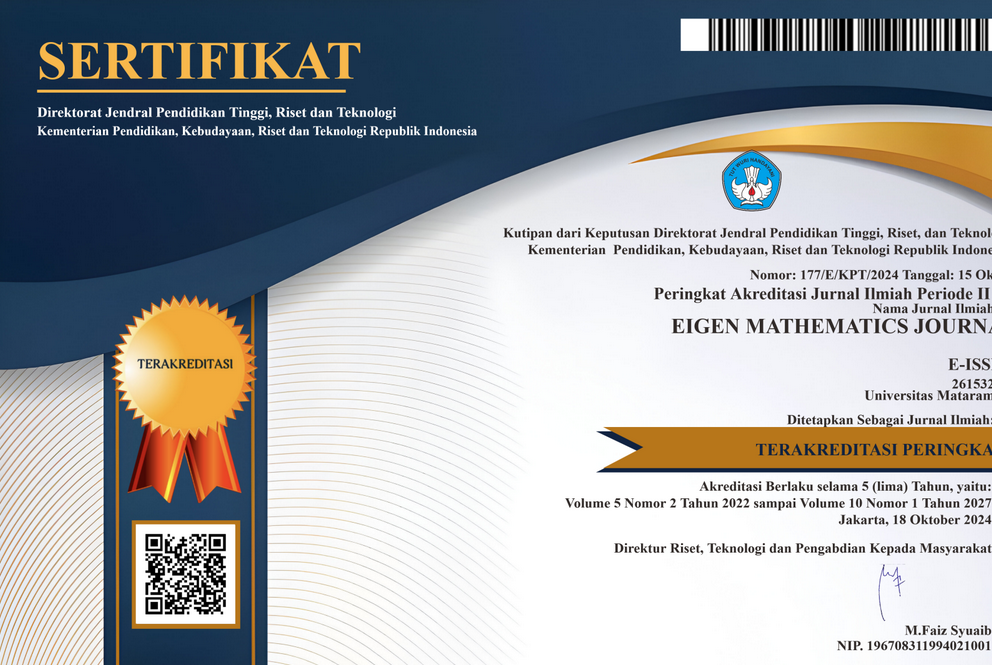Forecasting Non-Metal and Rock Mineral (MBLB) Tax Revenue Using the Fuzzy Time Series Markov Chain Method in East Lombok Regency
DOI:
https://doi.org/10.29303/emj.v7i1.171Keywords:
Fuzzy time series markov chain, MAPE (Mean Absolute Percentage Error), MBLB taxAbstract
Indonesia is one of the countries that is included in a developing countries. Therefore, the Indonesian Goverment is trying to carry out various developments in various regions. Regional development is one of the Indonesian government’s ways of achieving national goals. In carrying out regional development, of course funds are needed as the main source to support the achievement of national development. The main source of funds obtained by the Government comes from Regional Oroginal Income. One source of Regional Oroginal Income is tax. There are various types of taxes managed by the government in East Lombok Regency. One of them is the Non-Metal Minerals and Rocks, which is a tax on the extraction of non-metallic minerals and rock Tax, which is a tax on the extraction of of non-metallic minerals and rocks from natural sources within or on the surface of the earth for use. This Non-Metal and Rock Mineral tax provides quite large revenues for East Lombok district regional taxes. Non-Metal and Rock Mineral tax income is often not constant, meaning that there is an increases and there is a decreases in the amount of income. For this reason, it is necessary to forecast Non-Metal and Rock Mineral tax revenue to predict income in the future. The method used in this study is the FTS Markov Chain order 1 and order 2. Based on the MAPE indicator, the results of forecasting using the FTS Markov Chain method of order 1 amounted to Rp. 1.117.069.497 with an accuracy of 48,55% with a just good forecasting classification. While the results of forecasting using the FTS Markov Chain method of order 2 amounted to Rp.1.761.652.173 with an accuracy of 39,12% with a just good forecasting classification. If seen from the MAPE value obtained, the forecasting results using the 2nd order FTS Markov Chain are more accurate than using the 1st order Markov Chain FTS method.References
Fauziah, Normalita., Sri Wahyuningsih., Yuki Novia Nasution. 2016. Peramalan Menggunakan Fuzzy Time Series Chen (Studi Kasus : Curah Hujan Kota Samarinda). Statistika 4(2).
Halim, abdul. 2014. Manajemen Keuangan Daerah, Edisi Revisi Yogyakarta.
https://bapenda.lomboktimurkab.go.id Sejarah Bapenda, diakses tanggal 26/3/22 Pukul 10.47
Junaidi, N.A. Wijono, Erni Yudaningtias. 2015. Model Average Based Fuzzy Time Series Markov Chain Untuk Penggunaan Bandwidth Jaringan Komputer. 31-36.
Song dan Chissom. 1993. Forecasting Enrollments With Fuzzy Time Series - Part I Fuzzy Sets Syst. 54 (1) PP. 1 – 9.
Tsaur R.C. 2011. A Fuzzy Time Series-Markov Chain Model With An Application To Forecast The Exchange Rate Between The Taiwan And UD Dollar. ICIC International.
Downloads
Published
How to Cite
Issue
Section
License

This work is licensed under a Creative Commons Attribution-NonCommercial-ShareAlike 4.0 International License.
All articles published in the Eigen Mathematics Journal will be available for free reading and downloading. The license applied to this journal is Creative Commons Attribution-Non-Commercial-Share Alike (CC BY-NC-SA).
Most read articles by the same author(s)
- Lukman Ibrahim, Syamsul Bahri, Irwansyah -, Penerapan aritmatika modulo untuk menguji validitas dan mengembangkan nomor ISBN (International Standard Book Number) , EIGEN MATHEMATICS JOURNAL: Vol. 1 No. 2 Desember 2018
- Moudy Puspita Ayudhiah, Syamsul Bahri, Nurul Fitriyani, Peramalan Indeks Harga Konsumen Kota Mataram Menggunakan Vector Autoregressive Integrated Moving Average , EIGEN MATHEMATICS JOURNAL: Vol. 3 No. 1 Juni 2020
- Baiq Urfa Justitiaski, Nurul Fitriyani, Syamsul Bahri, Modeling the Number of Infant Mortality in East Lombok using Geographically Weighted Poisson Regression , EIGEN MATHEMATICS JOURNAL: Vol. 5 No. 2 Desember 2022
- Gangga Anuraga, Dito Anurogo, Fenny Fitriani, Hani Brilianti Rochmanto, Zulhan Widya Baskara, Integrative Bioinformatics and Statistical Approaches for Identifying Prognostic Biomarkers and Therapeutic Targets in Breast Cancer , EIGEN MATHEMATICS JOURNAL: Vol. 8 No. 1 (2025): June
- Zulhan Widya Baskara, Lisa Harsyiah, Dewa Nyoman Adi Paramartha, Qabul Dinanta Utama, Factor Analysis for Mapping Characteristics in Robusta Coffee Decaffeination Experiments , EIGEN MATHEMATICS JOURNAL: Vol. 5 No. 1 Juni 2022
- Sulpaiyah Sulpaiyah, Syamsul Bahri, Lisa Harsyiah, Forecasting Rice Price with Double Exponential Smoothing and Fuzzy Time Series Methods (Case Study: Price of Rice in Mataram City) , EIGEN MATHEMATICS JOURNAL: Vol. 5 No. 2 Desember 2022
- Masriani Masriani, Qurratul Aini, Syamsul Bahri, Fuzzy Metric Space and Its Topological Properties , EIGEN MATHEMATICS JOURNAL: Vol. 4 No. 2 Desember 2021
- Husnul Hotimah, Syamsul Bahri, Lailia Awalushaumi, Modification of the Edmonds-Karp Algorithm to Determine Maximum Flow in PDAM Water Distribution Networks (Case Study: Telaga Sari PDAM Giri Menang Mataram) , EIGEN MATHEMATICS JOURNAL: Vol. 6 No. 2 (2023): December
- Nurul Hikmah, Syamsul Bahri, Irwansyah Irwansyah, A Neural Network Prediction of Ozone Level in Mataram City , EIGEN MATHEMATICS JOURNAL: Vol. 5 No. 2 Desember 2022
- Putri Rahmasari Rayes, Nuzla Af'idatur Robbaniyyah, Syamsul Bahri, Implementation of Fast Fourier Transform and Least Mean Square Algorithms in The Denoising Process of Audio Signal , EIGEN MATHEMATICS JOURNAL: Vol. 8 No. 1 (2025): June






